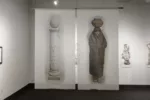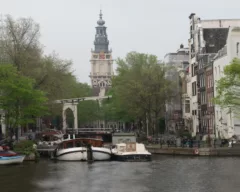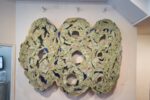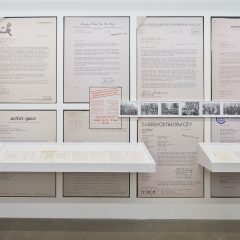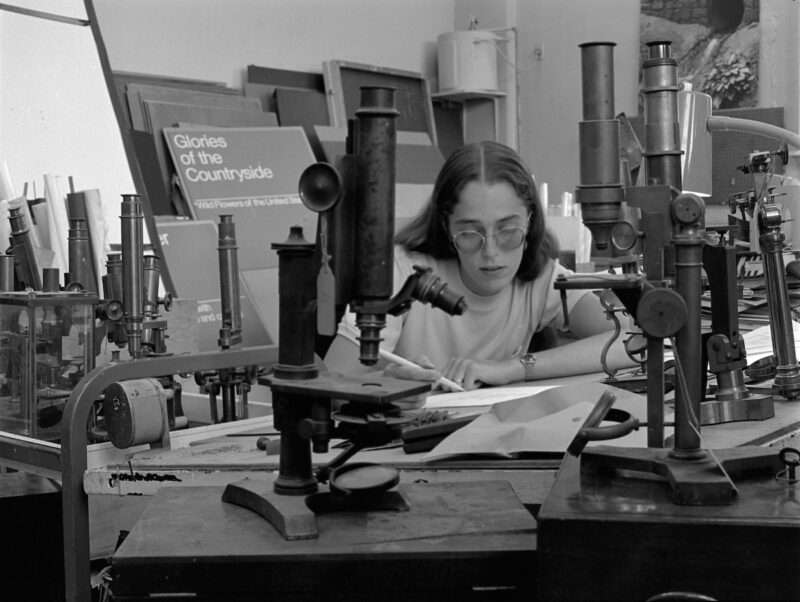
Photographer Blaise Tobia and sculptor Virginia Maksymowicz have been pursuing their careers for fifty years–as artists and as educators– and readers of Artblog will most likely be familiar with their work from reviews and from their own writings. They’ve also been pursuing the art of marriage (to each other) for the same fifty years. That seems long enough for them to qualify as the “true minds” Shakespeare had in mind— the ones to whom the poet would not admit impediments.
Today we might say they possess that most prized attribute—“sustainability.” We think of the word in connection with the environment, but what about ourselves? How do any of us, especially artists, sustain our creativity? How do we connect the present with the past? What things stay constant, and what things change? What kind of “recycling”—the key to ecological sustainability— do we do in our own lives and what new inventions do we bring to the project?
These big questions will not be answered to anyone’s satisfaction here, least of all to my own. But having first encountered the work of Tobia and Maksymowicz over 30 years ago, I now wanted to get a bigger picture of their creative careers, and my quest began with a visit to their West Philadelphia studio, which Blaise had told me was housed in a historic building, adding that I should be sure to read the plaque outside. He wasn’t kidding. The nondescript brick building on Lancaster Avenue had served, in the 1950s and 60s, as the Temple of Islam #12, occupied by Elijah Muhammad and his followers, including Malcolm X. More recently the building had been converted to art studios, and since 2020 Tobia and Maksymowicz have been in the space, which is not far from where they live. They occupy separate rooms, each neatly ordered and across from one another, with a hallway in between which doubles as a gallery. Blaise, working in two dimensions, has photographic prints, books, papers, and computers in his room, along with a small conference table; Virginia, who works largely in three dimensions (she also draws) has a work table, shelves stacked with molds and casts reaching to the ceiling, and too much other stuff for me to take note of.
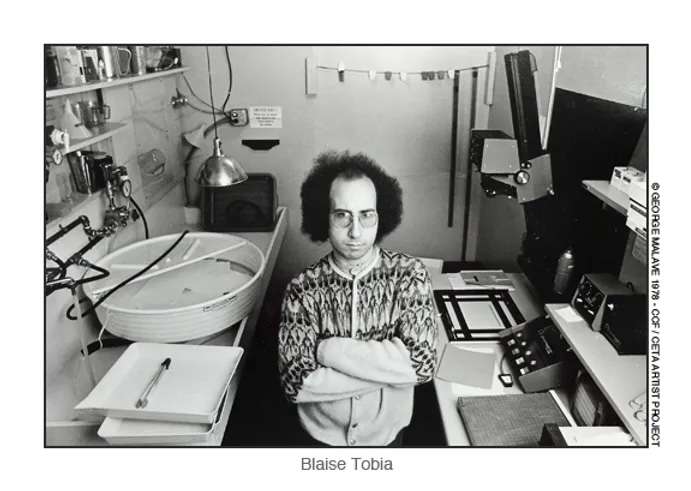
Tobia and Maksymowicz would be the first to proclaim their collaborative enterprise in art and in life, and anyone looking for them online will find their joint logo, TandM Arts, which stands as the gateway to their individual websites. Relationships endure for many reasons, and I’ll leave the finer points to marriage specialists, but I’m guessing that like all bonds (cf. Velcro) it has to do with similarity and difference. As artists, they understand one another. As artists working in different media–this is a crucial point underlined by Maksymowicz–they don’t feel they’re in competition. Blaise’s work is primarily photography; Virginia’s is primarily sculpture.
It’s also worth mentioning that they were born on the same planet, Brooklyn, though at opposite ends of the giant borough, before they met in the middle, at Brooklyn College. (By divine coincidence, their present studio borders on Brooklyn Street.) Tobia and Maksymowicz both graduated as art majors (Tobia switched from physics) with strong backgrounds in art history and a strong foundation in Modernism. They were at Brooklyn when the Art Department was chaired by Morris Dorsky, who was a link to earlier Brooklyn College art faculty like Rothko, Reinhardt, Lennart Anderson, Philip Pearlstein, and many others. Lucas Samaras was also there, and his Polaroid self-portraits could have set off flash bulb for Virginia, who would go on to use her own body as a template for a whole series of later works. Meanwhile, Tobia studied with documentary photographer Walter Rosenblum, who was mentored by Paul Strand and Lewis Hine and was president of the Photo League (which included Dorothea Lange, Ansel Adams, Edward Weston, etc.) when it was blacklisted in 1947 by the U.S. Attorney General.
Brooklyn College was a perfect beginning for both Tobia and Maksymowicz, but it was also a time, as Virginia made clear in conversation, when the female artist, the female professional of any kind, was unsupported by a largely male establishment. (Both high-achievers, Blaise turned down Phi Beta Kappa because Virginia had not been offered membership the year before.) Even so, at Brooklyn, Maksymowicz, always a superb draftsman, found her art practice transformed when she got interested in the art and craft of cast-making, a skill that would form the rock, so to speak, of her developing career in sculpture.
Leaving the East for graduate school, Tobia and Maksymowicz found themselves at UC San Diego, where the MFA was a three year program that included lots of writing (including a thesis) and exposure to a new world of theory and practice that laid a layer of new thinking on top of their more traditional undergraduate degree. The UCSD program around that time was Futureworld, a multi-disciplinary program that included a studio arts faculty that was augmented by poet and art critic David Antin, conceptual artist Eleanor Antin, performance artist Allan Kaprow (Happenings), computer artist Harold Cohen, and recent graduates Allan Sekula and Martha Rosler, icons of a new political conceptualism in the arts. The place was a West Coast Bauhaus, a San Diego Black Mountain, not as cool as the Jack Kerouac School of Disembodied Poetics founded by Allen Ginsberg in Colorado, but it was definitely cool, and going to UCSD at that time would be approximately like studying philosophy in 4th century BC Athens at Plato’s Academy.
Graduating with their MFA degrees in 1977, Tobia and Maksymowicz were superbly equipped to become great artists, or–given the marketplace for the arts– unemployed artists. They moved back to Brooklyn and lived with Tobia’s parents. Yet there, against all odds, they were both, within a year or two, able to land jobs as artists. That sounds like a misstatement— jobs as artists—but in those mythical, pre-Reagan days, there was actually a government-funded program to employ artists–as teachers, designers, installation experts, who were given one day a week to do their own work while on the payroll. This extraordinary program, costing the government practically nothing, was the Comprehensive Employment and Training Act (CETA, 1974-81), which included funding to employ artists, and Tobia and Maksymowicz worked as part of the New York State component, called —the Cultural Council Foundation, which employed around 300 artists in the late ‘70s. (Philadelphia had its own version of CETA, the Brandywine Workshop.) These arts programs were modeled on the equally extraordinary multi-faceted Federal Arts Project of the 1930s, a part of FDR’s Works Progress Administration during the New Deal.
While working for the New York program, Tobia created photographic documentaries of their activities across the city, creating an invaluable record of the project. Maksymowicz was teaching and working in a variety of arts positions. They credit those years after graduate school as a second training in the reality of being an artist, learning about the infrastructure of art practice, the essential work that happens outside the studio, work that connects the artist with the community and with what non-artists like to call, mysteriously, “the real world.”
Following the CETA years (there was a two-year limit on employment), both Tobia and Maksymowicz engaged in a variety of jobs, including lots of adjunct teaching, editing, and arts administration, while continuing to develop their own careers in photography and sculpture. Eventually, the Art Gods smiled on them: Blaise landed a full time position in the photography program at Drexel’s College of Media Arts & Design, where he stayed for the rest of his teaching career. Not long afterwards, Virginia was hired at Franklin and Marshall in Lancaster, where she remained until retirement in 2018.
Visiting any artist’s studio, you might expect to gain a sense of the artist’s incubation space, where the work is generated and “created,” at least in the planning stages. You might also expect to see a fuller range of the artist’s spectrum, from start to finish. In this case, I left the Lancaster Avenue studio with a sense that I’d seen many pieces, many fragments, many narratives left untold. I had seen, to coin a phrase, the tip of the iceberg.
So where was it— the iceberg itself?
The answer, I realized, was obvious: in the year 2024, if you are interested in getting an overview of the artist’s career—especially when the artists in question have had the long careers that Tobia and Maksymowicz have had—a studio visit offers only a limited exposure to their achievements. In the age of websites, the “reality” of the studio is in some ways ancillary to the more complete virtual reality of the website. No one is likely to say, hey come over to my website for a cup of coffee, so let’s do hold on to the idea of the studio visit. But when I left, I knew I would have to visit, seriously visit, their websites to get the fuller picture I wanted.
As a matter of fact, however, this is the second time I was writing about Tobia and Maksymowicz; and the first time—back in 1992—I must admit, was much easier. I had been asked to write a catalog essay for an exhibition about art and politics at the Abington Art Center organized by Laura Burnham, called American Pie: Myth Representation, a show that included—in addition to Tobia and Maksymowicz— video artists Connie Coleman and Alan Powell. Sitting in the Lancaster Avenue studio, we all remembered it as if from another time, which it was.
Now, more than thirty years later, I was looking at a body of work–two bodies of work, I mean–most of which didn’t exist at the time. What lines of connection might be visible between past and present? what patterns might be visible across these years?
I’ll start with the photographs of Blaise Tobia.
Blaise Tobia
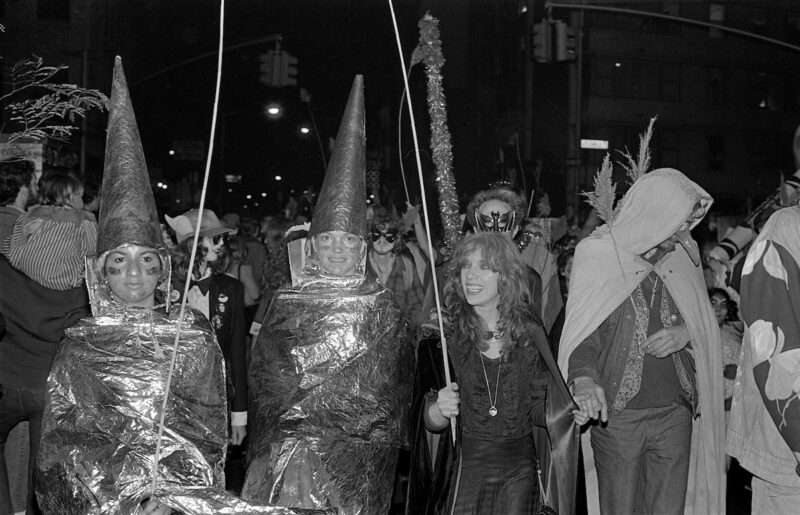
The art of photography is the art of looking – and framing. Photographers see something worthy of notice and take the picture, and by making that record they identify and name it as something others should look at. This simple act of observation is the foundation of landscape photography (natural or urban) and of “street photography,” where the flaneur with a camera is strolling through the city, snapping pictures as they appear before the searching eye. The photographer’s speed is essential here, since things can change quickly, before you have time to get your camera ready. The master of this mode, who danced through the streets, was Henri Cartier-Bresson, his Leica always poised for action. Another master at observing the incongruous—whether in motion or at rest, was Walker Evans. Tobia is very good at this. He has the collector’s eye for the strange and interesting, and he is also alert to incongruities, able to see the irony of things that most of us would miss.
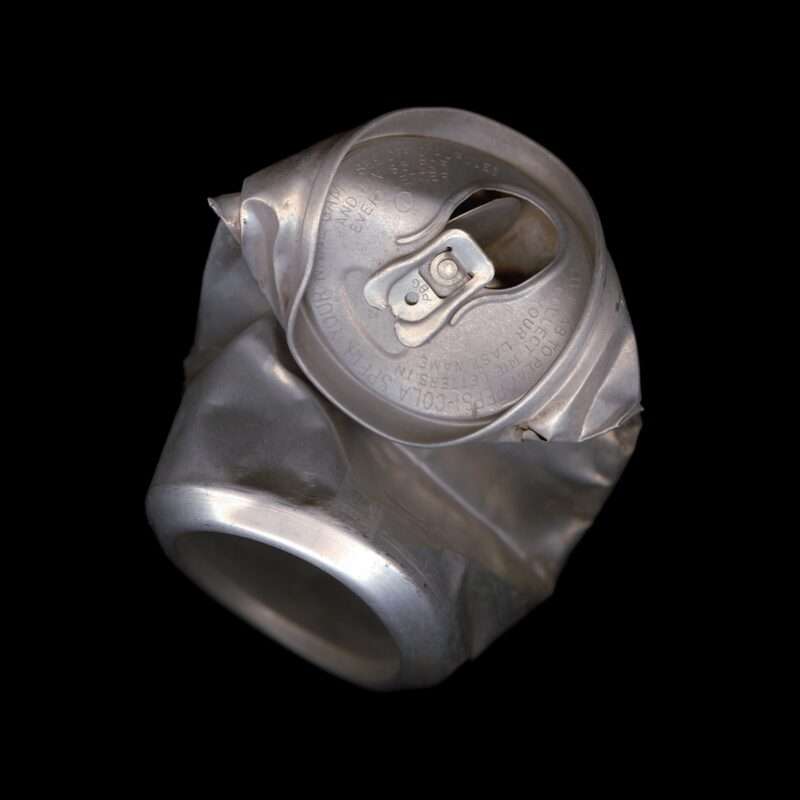
Many of Tobia’s “street photographs” are on his website under one of his main categories, “Compilations,” and here he has made use of the Flickr platform to gather and group highlights (usually based on place) from his personal archive of 100,000 images. Here, we can visit Buenos Aires, Ireland, Mardi Gras in New Orleans, Halloween in New York. Another grouping is the very early documentary photography Tobia did while he was working for the CCF/CETA project in New York City, which the photographer is turning into a permanent museum archive.
Otherwise, in addition to the street photography just mentioned, Tobia’s website displays a great many interesting projects, and I could have spent days looking at them. He has created a system of folders and sub-folders to contain his work, and Tobia’s categories and groupings all make sense. But personally I found it confusing at times, like entering a vast department store where you can’t quite get the hang of what “department” you’re in. It’s huge, it’s engaging, but it’s a bit overwhelming.
For purposes of discussing these projects, let me divide them into three main genres, each representing a distinct aesthetic purpose: fine art prints, paired images, and narrated images.
In the “fine art prints,” Tobia exhibits a variety of approaches: some are close-up fragments of the material world (walls, surfaces, textures) that puzzle our eye as abstractions; others are close-up images of entirely recognizable things that reveal their structure and texture, e.g. a circular saw blade, or a tin can that is sensuous enough to bear comparison with Edward Weston’s famous peppers. Another type of “fine art” image is the composite—broken panoramas that are rearranged as a collage of related images. These images, giving evidence of the photographer’s Modernist lineage, are all aesthetically powerful.
But Tobia’s special gift, I would say, lies in the second genre I have noted—the paired images— where he puts two pictures together and challenges us (without text) to see what unites them. Sometimes it’s form; and sometimes it’s a combination of form and theme. Sometimes there’s a horizontal break between the two; and sometimes (in later work) the break is erased, creating more ambiguity. These are a pleasure to look at, and they remind me of some of Robert Rauschenberg’s paired photographs (1981) or the little known but fascinating gathering of images by Marcelo Brodsky, Martin Parr and others, called Visual Correspondences (2009). What Tobia deftly demonstrates in his own pairings is how two images can create a wordless “meaning” when one is put in “conversation” with a second image, exemplifying the essence of visual wit. Grasping that meaning is immediately gratifying, but having to describe it would be tedious, as Freud demonstrated in his own writings on humor, where he over-explains his jokes. OK, he had his reasons.
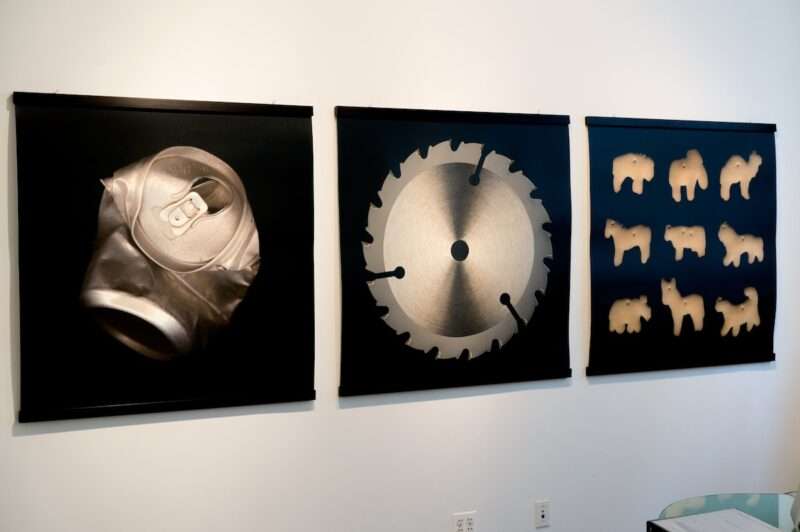
The pairing of two images exemplifies how photography can be used to create a special kind of meaning–without any needed titles or captions. Though not common in photographic practice, the method is fundamental to film, based on Eisenstein’s cinematic theory of the montage, in which a new meaning can be created by juxtaposing one film scene against a very different scene without any transition. Tobia is picking up on another legacy of Modernism (cf. Kenneth Burke’s “perspective by incongruity”) and recycling it in ways that are fresh and inventive.
The third genre, the “narrated image” consists of a combination of words and images, and hereTobia’s genius for creating complex meaning is on display in a form that’s different from the paired (and wordless) images just discussed. In this third genre, Tobia’s own written texts “explain” or comment on the images in whimsical narratives that “interpret” the image or introduce irrelevant subjectivities, a sort of parody of ekphrasis—which is the classical trope in which the poet offers a detailed verbal parallel to a visual image. (Achilles’ shield in the Iliad is the common example.). My own favorites in this third genre can be found in the “Text + Image Series” on the Second Floor of the Tobia Department Store: Caveat Emptor, Crater Lake, Surveillance, Direct Objects.
At his best, Tobia is a master of counterpoint, which he practices with a deadpan humor that is the equivalent, you might say, of the expression on Tobia’s face in the self-portrait on his website. Like all self-portraits, this one is a kind of performance, and the persona on view features the ingenuous stare of the ironist. It reminds me of Buster Keaton— and Tobia uses the baseball cap the way Keaton used the pork pie.
Thinking in more general terms about art and websites—true for Tobia and Maksymowicz alike—it’s worth noting that all of the work that’s posted online originated outside the web—in gallery shows and exhibitions for the most part. The website is a new answer to an old question: How does an artist’s work live beyond its creation and its exhibition? Few works make it into museum collections, and if they do, they may be locked in a basement storage for years. In the pre-digital age, you might be lucky if your work was accompanied by an exhibition catalog. In the digital age, you have two new options: one is the book on demand, in which the photographer can gather work and easily print a collection in a permanent form for the viewer who wants a book to hold. (Tobia has many such on-demand books https://www.blaisetobia.com/book-works for sale.). The other enduring form is the website itself, less permanent perhaps than a printed book, but fairly durable nevertheless.
We may be at an interesting turning point in art consumption, with galleries struggling in the same way that brick and mortar stores are struggling. With the exception of the faithful, galleries don’t see a lot of traffic. (Thank God someone invented First Fridays.) After the gala opening party, the place grows quiet; and after the show comes down, it’s over. If you missed it, too bad. The virtue of the website is that the show can continue in another form. It never ends. (“Never” is an exaggeration. Someday everything will end.)
Virginia Maksymowicz
Turning from Tobia to Maksymowicz (her students at F&M solved the spelling problem by calling her Prof. Maks), we enter a different creative universe, a different epistemology even, so different that we might almost create a ratio of sorts: Tobia is to Empiricism as Maksymowicz is to Rationalism. Where Tobia creates his world out of the visible things of the earth and the way they look to us, in the camera’s eye at least, Maksymowicz creates her world out of reason, knowledge and abstract concepts. Tobia begins with the world as it is and ends, often, in an idea; Maksymowicz begins with an idea, often based on cultural history and gender, and ends in a three dimensional sculpture or installation.
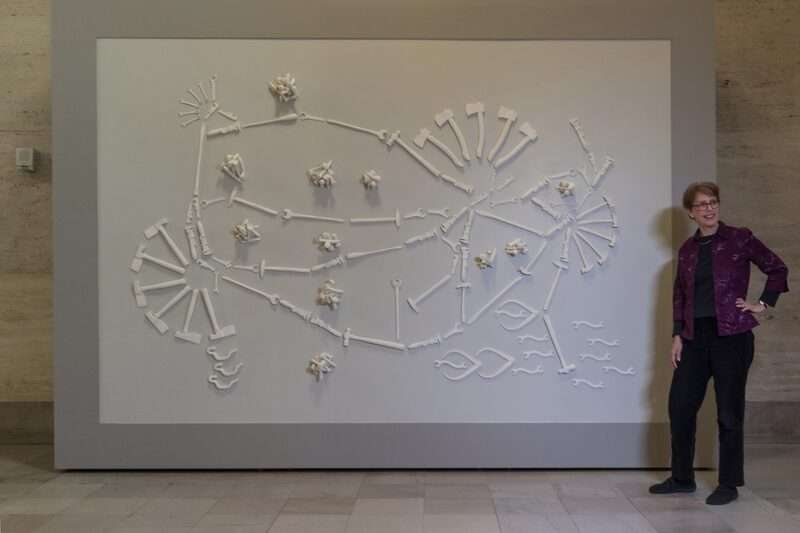
What she does with the idea—giving it material form as an artwork—is, of course, her own special virtuosity. Maksymowicz is a public artist whose work has appeared in many outdoor and indoor spaces (see her website); and her designs communicate through a subtle wit that is embodied in a shocking—sometimes a beautiful—visual image whose meaning becomes clarified as you begin to decipher it. Often, the “embodiment” of the idea is a literal representation of the human body—more specifically the female body. And her favorite technique for creating that body is to cast it from molds, a method that replicates the surface shape and texture of the original, thus creating a literal “index” of the object. (Index in the sense of a one-to-one relationship between the original and the replica.)
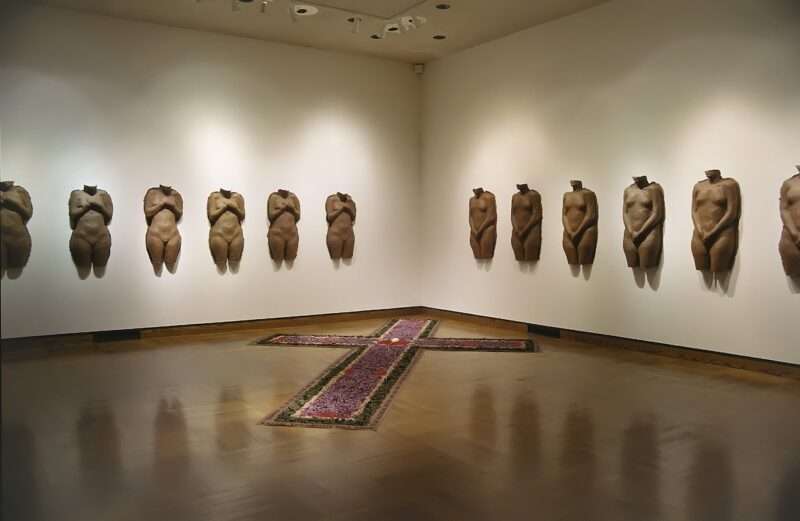
In effect the two artists are doing the same thing. That is, they are both “indexical” artists, creating works that have a direct correspondence (like an index) to reality. Maksymowicz literally creates her casts from body molds. Photographs—people used to think—do something very similar. In the earliest days of photography, when the camera seemed like an instrument of magic, some people believed that the photographer was capturing the outer “film” of things, the layer of reality that we could see. The more photographs you made of something, the more layers were removed. If you believed this, you didn’t want to have your picture taken too often, or, by this questionable logic, you might physically disappear. (This is not a bad metaphor for pop culture, in which celebrities, constantly photographed, do “disappear” in a way, losing their inner selves the more they are pictured in the public media.)
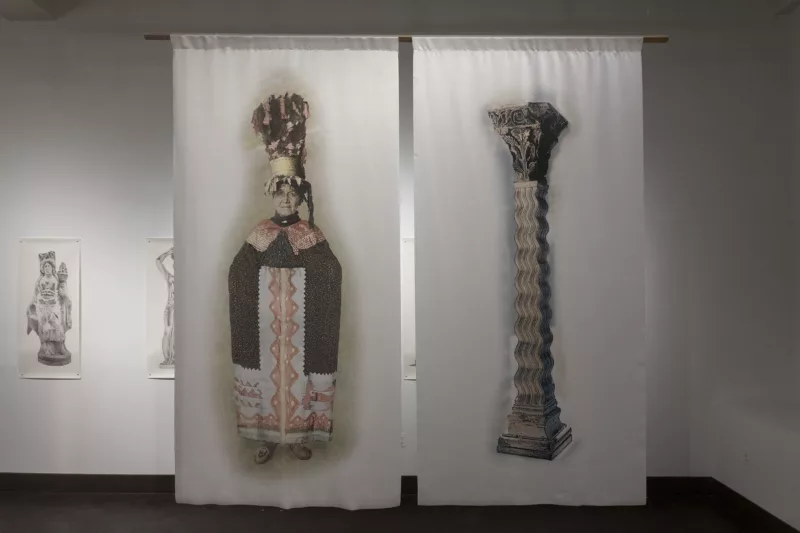
But let’s get back to Maksymowicz, who disappears, one might say, into her own work, when she uses her own body as the starting point for the mold. There is a nice irony in this practice: in constructing her feminist critique of patriarchal society, Maksymowicz wryly “clothes” her abstractions in the form of the female body, which has been for centuries the favorite subject of male artists. From the beginning of her career, Maksymowicz has used “beauty” as the vehicle for her social and cultural critique of patriarchal cultures, seducing the viewer into an engagement with the work that advances from first look to an eventual understanding of the intellectual grounds of her satire or critique. We can see this technique in her widely known History of Art (1983—ongoing), in which Maksymowicz illustrates the predominantly male history of art through a series of female torsos, each of which features an image representing an iconic period style or movement painted on handmade paper cast from a body mold.
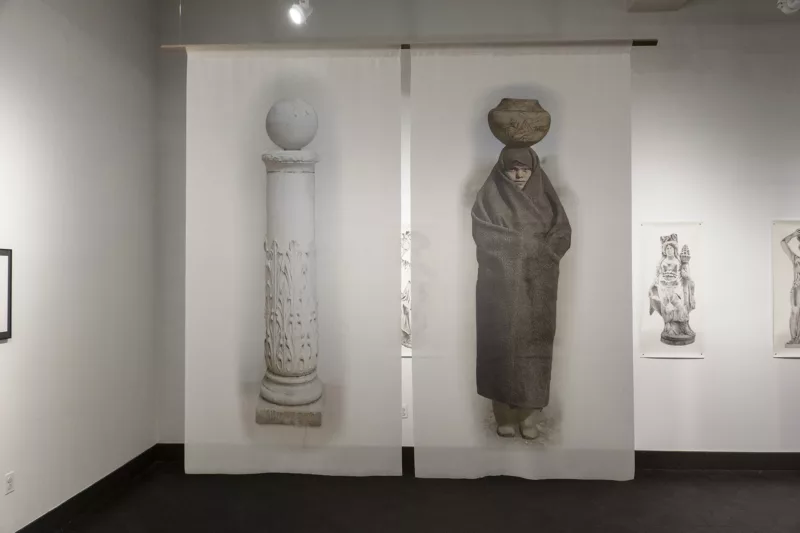
Still using the female body as an aesthetic object, Maksymowicz used a different approach in a big show (Fall 23) at the Rowan University Art Gallery and Museum, The Lightness of Bearing. This project also has large art-historical themes running through it, demonstrating the universality, across many cultures, of the so-called “natural” role of women, which is to bear the weight of the world. Women bear children during pregnancy and they carry the baby after it’s born; they carry water and goods of all kinds, often in baskets that they balance on their heads. Some of the earliest representations of women in art—the caryatid columns that support Greek temples—are recurring figures in Maksymowicz; her installations are an ironic commentary on a cultural tradition that enshrines and beautifies the female form while sentencing women to a permanent architectural fate, bearing the weight of the building while still keeping their balance and grace. This division of labor isn’t merely “traditional”: in contemporary society, it’s not unusual to see women shlepping the kids and the groceries while men dance around in their Nikes.
The Lightness of Bearing expands this theme in a variety of components that allude to classical forms and myths—e.g. the acanthus-leaf baskets overflowing with loaves of bread; or columns crowned with sculpted open book pages with drawings of caryatids facing lines of poetry. Most notably the theme is used in life-sized palimpsestic cloth hangings that superimpose two or more images—a caryatid and a contemporary woman (often from a non-Western culture) the latter echoing the classical model, both images bearing weights on their head. As the hangings move gently in the breeze of air conditioning currents, you can see the two images as adjacent or as overlapping figures.
Embodying abstractions in these sensuous forms, Maksymowicz’s is an art of incarnation, a phrase I use deliberately to suggest the religious dimensions of her art. In fact, Maksymowicz has written about the vital significance of her Catholic background, and you can see themes running throughout her career that relate the human form to myth, seasonal cycles, and religious ritual, most obviously in work commissioned by Christian religious communities. One example is her powerful 2005 series of bas-reliefs Stations of the Cross (cast in Hydrofocal FGR 95) created for St. Thomas Episcopal Church in Lancaster, PA. Another is the daring collection of bas-reliefs, called Garden of Earthly Delights, made for St. Joseph’s University, which features the heads of women whose mouths have been uncomfortably stuffed with fruit, while underneath each gagged woman is a single word, also in relief, that is typically used to describe both fruit and women—e.g. tart, firm, ripe, etc.
There is no contradiction between being a “religious” artist and working at the forefront of conceptual installation art, but it’s an unusual combination. And, just to clarify, Maksymowicz’s perspective is ecumenical (as opposed to parochial). If Catholicism is a living force for Maksymowicz, it is the social justice traditions of the Church we’re talking about. Even when she is being doctrinal (as in the Stations of the Cross), Maksymowicz is making her own point, by deliberately using a range of diverse models to serve as “Christ.”
Maksymowicz reminds me, in some ways, of another Catholic artist, the Southern writer Flannery O’Connor, who wrote in the 1950s and 60s. In both artists—and leaving aside the millions of differences between them—you can see a droll humor and immediacy of effect at the edge of the grotesque, concealing an appreciation for the presence of hidden meanings in the mundane surfaces of everyday life. O’Connor, one of America’s greatest short story writers, had a relatively brief career, lasting about fifteen years before she died of lupus. Maksymowicz’s prolific career is still going, after fifty years–which brings me back to my starting point about art, life, and sustainability.
When I left the studio on Lancaster Avenue, I thought about how Tobia and Maksymowicz, these two Brooklyn-born artists, now Philadelphians, couldn’t be more different, in personality and practice— and also how they couldn’t be more alike. They have each followed, in their own ways, career trajectories that make visible the consistency of their practice, from early work to later. Yet they have also evolved unpredictably, expanding their range of practices over many years. You could see it as an artist’s version of sustainability–a kind of recycling—taking what we have and transforming it, using it, returning to it, letting it change and stay the same. A long artistic life is a kind of metamorphosis.
I don’t mean to construct an Ovidian fable here, or a monument. I suspect Tobia and Maksymowicz both dislike pedestals of all kinds. But let us cheerfully acknowledge their interrogation, if not refutation, of the assumed wisdom of William Butler Yeats. “The intellect of man is forced to choose,” Yeats wrote in The Choice, “ perfection of the life, or of the work,/And if it take the second must refuse/A heavenly mansion, raging in the dark.”
Ed. Note: Blaise and Virginia has written for Artblog for many years, about their travels, and their trips to the art fairs. Read a recent piece the two co-wrote about the Artomatic Fair in Washington, D.C.


